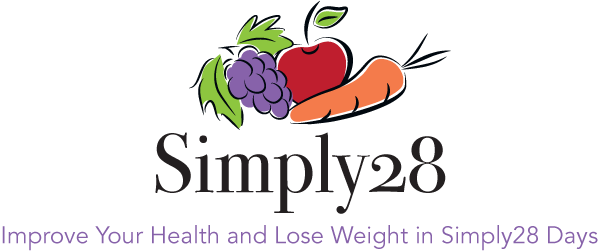The A1C test, also known as a hemoglobin A1C test, is a blood tests that indicates our cellular glycation, a fancy term for determining a person’s average blood sugar over the past three months. When sugar enters our blood stream it attaches to hemoglobin, a protein in our red blood cells. Everybody has some sugar attached to their hemoglobin, but people with chronically higher blood sugar levels have more. A normal A1C level would be below 5.7%. A level of 5.7% to 6.4% indicates prediabetes and a level of 6.5% or higher indicates diabetes. According to the CDC article Prevalence of Prediabetes Among Adults, between 2017-2020, 38% of all US adults had prediabetes based on their fasting glucose or A1C level.
For more information on what to eat, meal planning, and over 100 recipes, check out the link below for my newly released book, The Simply28 Real Food Cookbook.
The Standard American Diet (SAD) which is excessively high in sugar and refined carbohydrates and low in nutrients is inundating our bodies with an overwhelming amount of sugar. On average, Americans consume about 170 grams or 34 teaspoons of sugar per day and looks something like this.
Grams & Teaspoons of Sugar per Serving
| Coke | 39 grams | 8 teaspoons |
| 3 Oreos | 13 grams | 2 ½ teaspoons |
| Protein bar | 11-18 grams | 2 to 4 teaspoons |
| 1 cup Raisin Bran | 19 grams | 4 teaspoons |
| Yoplait Yogurt | 27 grams | 5 teaspoons |
| Bagel | 7 grams | 1 ½ teaspoons |
| Apple Juice | 26 grams | 5 teaspoons |
| Frappuccino | 31 grams | 6 teaspoons |
| Total | 173 grams | 34 teaspoons |
As you can see, what might seem like a fairly healthy breakfast of raisin bran, yogurt and a glass of juice could easily add up to about 14 teaspoons of sugar in just one meal!
Excess sugar not only raises blood sugar levels and A1C levels. It also depletes many B vitamins and minerals including thiamine, chromium and zinc, a powerful nutrient that supports our immune system. Excess sugar reduces the production of certain enzymes needed for hormone production and a variety of other functions especially in the liver. It can contribute to skin conditions, allergies, inflammation, and depression.
A1C and Cellular Glycation
Our red blood cells contain a form of protein called hemoglobin. When sugar attaches to hemoglobin proteins, the protein becomes sticky. These “sticky proteins” cannot be used by the cells to build structure or to communicate with other cells. Instead, they stick to the cell membrane and begin to harden. This interferes with insulin’s ability to communicate with the cell, remove sugar from the blood stream, and to store energy for future use. It also interferes with the cells ability to move nutrients in to the cell and toxins out. Think of a piece of toast verses a piece of soft white bread. Toasted, the bread has a harder surface than the piece of soft white bread. A glycated cell is much like a toasted piece of bread that has hardened on the surface making it less pliable and difficult to penetrate the outer layer. Whereas a healthy non-glycated cell allows the flow of nutrients and can bend and flex making it easier to move through tiny arteries and veins.
Elevated levels of glycated cells leads to high levels of A1C and can lead to metabolic syndrome, pre-diabetes, type 2 diabetes and even cardiovascular disease.
Interesting to note that Alzheimer’s patients tend to have high levels of advanced glycation end products. Alzheimer’s is strongly correlated with blood sugar and insulin resistance in the brain. It is now referred to as type 3 diabetes by health care professionals.
Elevated A1C levels is an indicator that diabetes is either currently present or just around the corner in which the pancreas is no longer able to produce enough insulin to keep up with the demand of a diet high in sugar and refined carbohydrates.
How to Lower You’re A1C Levels Naturally
How can you lower your A1C levels naturally, avoid the high cost of medical bills that accompanies a diabetes diagnoses, and avoid a long list of side effects that could potentially have a negative impact on your health?
The most important and effective way to reduce both your fasting glucose levels and your A1C levels is through diet. What we eat, our timing of snacks and meals, and the balance of meals is all very important to normalize blood sugar levels and reduce A1C. Let’s start with what to eat.
What to Eat – Choosing foods that are not processed and that are naturally low in sugar is essential. Eat a variety of foods including meat, poultry, fish, eggs, whole milk dairy if tolerated, vegetables and not more than 1 or 2 servings of fruit and starchy vegetables daily. More fruit may be added later but fruit contains the natural sugar fructose and impacts blood sugar. Also, include plenty of healthy fats such as avocado, avocado oil, nuts, seeds, olive oil, butter, and aged cheese. Avoid all processed foods that come in a package or box. Avoid white flour and white sugar, sugary drinks, and soda. Also, avoid consuming imitation dairy products, dairy creamers, trans fats and highly processed and toxic oils including canola oil, vegetable oils, corn oil, soy oil, and margarine.
Meal Timing – Reduce snacking between meals as much as possible. A fat burning metabolism should be able to go between 4 to 5 hours between meals comfortably. If you do need to snack make sure the snack is balanced.
Balancing Meals & Snacks – Most of us have heard that we should focus on well-balanced meals but what exactly does that look like. A well-balanced meal or snack should contain fat, protein and carbohydrates in their whole form, as close to how it is grown in nature as possible. Fiber from fruits and vegetables slows down the uptake of sugar and helps fill us up. Fat also slows the uptake of sugar into the blood stream and provides satiety for a longer period of time. And protein, helps to stabilize blood sugar for longer periods of time.
Below are some examples of balanced snacks and meals.
- Plain whole milk Greek yogurt, sweetened with fresh berries, and nuts.
- Handful of nuts either alone or with a small piece of fruit. (Nuts naturally have a balance of carbohydrate, fat and protein.
- A large salad, avocado, roasted chicken and dressing made with healthy fat or oil. (No fat free dressings as they are high in sugar).
- Salmon with grilled asparagus and a small potato.
- Rib eye steak, sliced tomato, and broccoli drizzled with olive oil or butter.
Most people are able to consume one or two servings of fruit or a small serving of a starchy vegetable such as potato, sweet potato, legumes or rice daily while continuing to lower their A1C levels. Others who are more sensitive might need to avoid these foods until their blood sugar levels are brought back in to the normal range.
How Long Will it Take to Lower My A1C?
Remember a hemoglobin A1C test is measuring the amount of cellular glycation that has occurred over the last 3 months. Once a cell has been damaged or glycated from too much sugar consumption it will not heal but instead needs time to die off. Red blood cells have a life span of about 90 days. As the old glycated cells die off, new cells are generating. It will take about 3 months of generating new healthy cells to take the place of the older glycated cells. Stay with your new program and know that each and every day you are growing healthy new cells that you are protecting by reducing your sugar intake.
Important Note!!! If you are currently taking any type of blood sugar lowering medication such as Metformin or insulin, your medication need will reduce as your fasting glucose levels and A1C levels go down. This can happen very quickly when you change your diet. You must consult with your physician before starting any new dietary regimen. Let them know about your new protocol and have them adjust your medication as needed.
Note: While an A1C test is a standard test to diagnose diabetes, there are several other factors that can cause a false test result including kidney failure, liver disease, certain medications, blood loss, and sometimes pregnancy. Let your doctor know if any of these factors apply to you when having your A1C levels checked.
Now Available!
My new book The Simply28 REAL Food Cookbook with everything you need to improve your health and live your healthiest life through real food is now available on Amazon! In this book I teach people how to get back to our roots of preparing and enjoying nutrient dense foods to lower blood sugar and A1C levels, boost your immune system, reduce bloating and intestinal discomfort, give you more energy and look and feel better than you ever have before! Plus, you will find over 100 easy to prepare gluten and grain free recipes.





